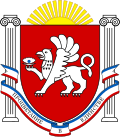| Constitution of the Republic of Crimea | |
|---|---|
| Ratified | 11 April 2014 (Crimea) |
| Purpose | Establishing Crimean status within Russia |
| This article is part of a series on the politics and government of |
| Crimea |
|---|
 |
| Autonomous Republic of Crimea (within Ukraine, 1991–present) |
|
| Republic of Crimea (territory occupied by Russia 2014–present) |
| See also |
| Political status of Crimea Politics of Russia • Politics of Ukraine |
The Constitution of the Republic of Crimea is the basic law of the Republic of Crimea as a claimed federal subject of Russia formed in the aftermath of the annexation of Crimea by the Russian Federation. It was ratified on 11 April 2014. [1] Its purpose is to replace the Constitution of the Autonomous Republic of Crimea based on the premise that it was repealed by a referendum during the 2014 Crimean crisis. The Ukrainian government and the majority of the international community do not recognize the annexation of Crimea by Russia and regard the Constitution of the Autonomous Republic of Crimea as active.